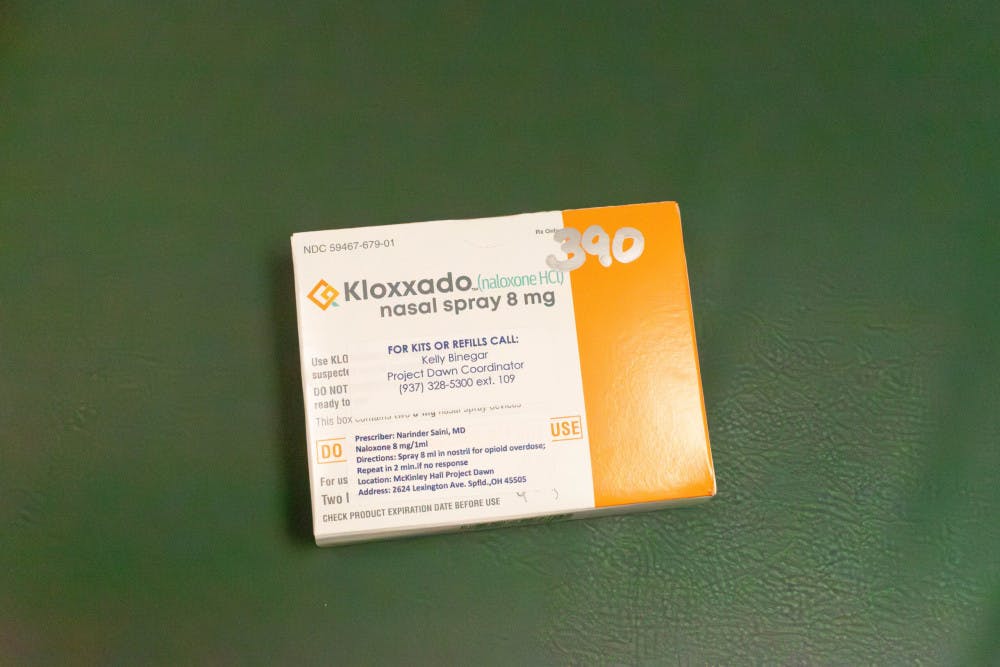NARCAN Distribution | Photo by Bethany Althauser | The Wright State Guardian
There have been increasing efforts to reduce drug-related accidents at Wright State University. One of these efforts is the recurring Public Safety NARCAN distribution events, with the most recent distribution on Thursday, Nov. 9.
What is harm reduction?
According to the NARCAN distribution slide show presented by Wright State Public Safety during the event, Dayton is an epicenter for the opioid crisis. Following guidelines drafted by the government, Wright State University put harm reduction measures in place to prevent drug-related incidents.
Harm reduction is an approach to addiction treatment and recovery that makes it safer for people who are struggling with addictions without requiring abstinence or avoidance.
One of the motivations for the NARCAN distribution and community education is that if someone is already doing drugs, there should be systems put in place to ensure that those doing them are not harmed or at risk while doing so. The most vital principle is kindness; people become addicted to drugs for many varying reasons.
There are many methods of harm reduction, including giving clean needles to drug users to prevent the spread of HPV and sometimes HIV, and, in the case of the NARCAN distribution, handing out NARCAN to save the lives of people who may be overdosing.
NARCAN distribution
The Wright State Police Department held the distribution in Rike 033. Teamed with Project DAWN, the distribution began with the officers handing out the NARCAN boxes. Each box contained two doses of the drug.
Participants were required to watch a PowerPoint and a series of videos to train them on how to properly use NARCAN to save lives. Afterward, the police answered any questions the audience might have. Before the event ended, participants had to register their boxes.
Several students asked questions throughout the presentation, and students departed feeling knowledgeable on the topic.
The questions asked during the distribution led to important information, including that you cannot harm someone if you administer NARCAN to them and they did not need it. Another is that Ohio has passed a law explaining that people who call the police when someone overdoses are not liable to a certain extent.
What is Project DAWN?
Project DAWN is a government-backed network that helps provide NARCAN to anyone who wants to decrease the amount of overdoses in their community.
The network’s name comes from Leslie Dawn Cooper, who, according to the Project DAWN website, died of an opioid overdose in 2009. The network provides learning materials as well as harm reduction outreach programs similar to the NARCAN distribution.
There are several Project DAWN locations around Ohio that aid in their cause. They are most typically health departments; however, Wright State University is one of the most recent Project DAWN centers to pop up.
Harm reduction and Wright State
NARCAN distributions are not the only thing that WSU is doing to ensure the safety of its students. In addition to NARCAN, students have access to fentanyl test strips as well.
Huma Bashir, the chair for the Department of Human Services at Wright State, stresses the importance of harm reduction.
“It’s all about harm-reduction care. Fentanyl itself is contributing to more overdoses in recent years. It is an extremely powerful and useful tool for medical uses. It’s when they use it over-the-counter that it becomes a problem, and that's why the fentanyl strips are just as important as the NARCAN. It can be mixed with anything sold on the street and you wouldn’t know,” Bashir said.
Overall, students feel positive about the steps towards better harm-reduction care.
Hannah Layton is a nursing student at Wright State. She feels excited with the additions that these efforts have put in place for students.
“I think that this is a wonderful resource for students. I believe that it’s important that students are educated on this topic,” Layton said. “I think this is something the school needs to push more advertising for. This is a matter of life or death for some people. These can be things that save people's lives in a matter of minutes.”
Layton was not the only student who felt positively about these changes. When asked, other students expressed positive sentiments about the program.
“I think it’s good. Why not? If it’s something that potentially can save someone's life, there isn’t any harm with having it on campus,” Joshua Buescher, a social science education major, said.
For now, students who want to participate in harm reduction can go to the Public Safety Office in the basement of Allyn Hall. Bashir said that in the future, Wright State should be adding lock boxes in high-traffic areas on campus; these boxes would include essential supplies students might need for harm reduction.
Bashir urges students to reach out for those resources if needed.
“Students won’t be judged for needing help. The truth is that we don’t know why they need the resources, so it’s not our place to judge, but it is to help,” Bashir said.
The next NARCAN distribution and education event will be on Thursday, Nov. 16, at 12 p.m. in 033 Rike Hall.













